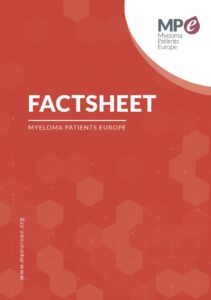What is Selinexor (Nexpovio®)?
Selinexor is a first-in-class selective inhibitor of nuclear export (SINE) drug that was granted conditional marketing authorisation from the European Commission in March 20211. Conditional marketing authorisation is granted to new drugs based on less comprehensive data than normally required if the medicines address unmet medical needs and if the medicines’ benefits are thought to outweigh their risks. The researchers must provide more comprehensive clinical data in the future to maintain approval status.
Selinexor is indicated in combination with dexamethasone for the treatment of multiple myeloma in adult patients, who have received at least four prior lines of therapy and whose disease is refractory to two immunomodulatory agents, an anti-CD38 monoclonal antibody, as well as at least two proteasome inhibitors, and whose disease progressed during their last therapy2.
How does selinexor work?
Selinexor binds to a nuclear export factor protein called exportin 1, thus blocking the transport of several proteins involved in cancer-cell growth from the cell nucleus to the rest of the cell. This may lead to cancerous myeloma cells being unable to grow and divide, therefore leading to death of the cancer cells3.
What are the benefits of selinexor?
Selinexor has been evaluated in several clinical studies, known as the STORM, STOMP and BOSTON trials. The STOMP and BOSTON studies are still ongoing3.
The phase 2 STORM clinical trial4 led to the approval of Selinexor for use in Europe. 122 relapsed/refractory multiple myeloma patients in the United States and Europe received 80mg of selinexor plus 20mg of dexamethasone twice weekly. 26% of patients saw an improvement in their myeloma and went about 3.7 months without their myeloma worsening. The overall survival of patients in the study was 8.6 months.
What are the side-effects of selinexor?
The most common side effects of selinexor are:
- Nausea
- Thrombocytopenia (low levels of platelets, a component of blood important for clotting)
- Fatigue
- Anaemia (low red blood cell count)
- Decreased appetite
- Decreased weight
- Diarrhoea
- Vomiting
- Hyponatraemia (low blood sodium level)
- Neutropenia (low levels of neutrophils, a type of white blood cell)
- Leukopenia (low white blood cell count)
How and when is selinexor given?
Selinexor is orally administered in the form of 20mg film-coated tablets. The recommended dose is 80mg4 per week. Selinexor is given on days 1 and 3 on a weekly basis in 4-week treatment cycles.
References
Nexpovio: European Medicines Agency.” European Medicines Agency, 2021: https://www.ema.europa.eu/en/medicines/human/EPAR/nexpovio
Nexpovio: Pending EC decision | European Medicines Agency. https://www. ema.europa.eu/en/medicines/human/summaries-opinion/nexpovio
“Oral Selinexor: First-In-Class Anti-Cancer Agent.” Karyopharm, https:// www.karyopharm.com/pipeline/oral-selinexor/
“Chari Et AL Oral Selinexor–Dexamethasone For Triple-Class Refractory Multiple Myeloma | NEJM.” New England Journal Of Medicine, 2019: https:// www.nejm.org/doi/full/10.1056/NEJMoa1903455
